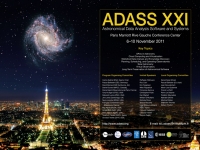András Pál (Konkoly Observatory)
Abstract
The method of Lie-integration is a very
effective algorithm for numerical solution of ordinary differential
equations. The principle of the algorithm is to compute the
coefficients of the Taylor-series for the solution involving
recurrence relations. This approach also yields more possibilities for
various types of adaptive integration since not only the integration
stepsize but simultaneously the polynomial order of the power series
expansion can also be altered. In addition, alternation of the
stepsize does not yield a loss in the (expensive) computing time. The
``disadvantage'' of the method is because of the recurrence formulae:
these set of equations depends on the particular problem itself and
therefore had to be derived in advance of the actual implementation.
However, the method is definitely faster than the classic known
explicit methods (that do not depend on the right-hand side of the
differential equation), has better error propagation properties and
the ``side-effect'' of knowing the analytic expansion of the solution
also allows us other kind of studies. The previously mentioned
recurrence relations are known for the N-body problem, thus the
dynamical analysis of planetary systems could be made very effective.
In this presentation we discuss the questions and possibilities
related to the implementation of the Lie-integration algorithm on GPU
architectures. We briefly summarize other advantages of this numerical
method that makes particularly suitable on GPU systems. For instance,
how the fact that the computation of the recurrence relations (in the
case of the N-body problem) needs only evaluating additions,
subtractions and multiplications can be exploited on GPUs. Initial
works show that studies related to exploration of the phase space
(thus as stability studies, where the similar dynamical system is
investigated in the case of various initial conditions) can be
achieved rather efficiently. Such studies are in the focus of
astronomical research in the case of both the Solar System and
extrasolar planetary systems as well.Poster in PDF format
Paper ID: P108
Poster Instructions
|

